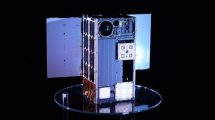 Spire Global has been awarded a contract by the Defense Advanced Research Projects Agency (DARPA) to deliver a preliminary design for a satellite that will carry an array of sensors to very low Earth orbit (VLEO) for in-situ ionosphere measurements.
Spire Global has been awarded a contract by the Defense Advanced Research Projects Agency (DARPA) to deliver a preliminary design for a satellite that will carry an array of sensors to very low Earth orbit (VLEO) for in-situ ionosphere measurements.
The award is part of DARPA’s Ouija programme, which aims to use sensors on satellites to provide new insights into high-frequency (HF) radio wave propagation in the ionosphere, the area spanning the upper edges of the Earth’s atmosphere to the lower regions of space. The programme seeks to quantify the space HF noise environment and improve the characterisation of the ionosphere to support novel HF capabilities.
DARPA’s award utilises Spire’s Space Services model, which offers organisations fast and scalable access to space through a subscription model that eliminates the high upfront cost of building and maintaining infrastructure in space. Organisations can leverage Spire’s established space, ground, and web infrastructure to deploy and operate a constellation of satellites, a hosted payload, or a software application in space. Spire handles the end-to-end management, from manufacturing to launch to satellite operations, and the customer operates the system through a web API.
Speaking about the contract, Kamal Arafeh, Senior Vice President of Sales at Spire, said: “Spire is proud to be supporting DARPA’s efforts to advance our understanding of the ionosphere. Spire has built and launched over 150 satellites in the decade since the company was founded, and we’re excited to bring that heritage and experience in ionospheric data collection to this project. For innovative programmes like Ouija, the Space Services model provides a fast and cost-effective platform to build and scale new technology in space.”
Recently, the company was also awarded a National Oceanic and Atmospheric Administration (NOAA) contract for its Space Services to develop a sensor with hyperspectral microwave sensing technology on a 16U satellite to collect near real-time weather observations and improve measurements.












Add Comment